Intercomparison of Landsat OLI and JPSS VIIRS Using a Combination of RadCalNet Sites as a Common Reference
Abstract
:1. Introduction
2. Materials and Methods
3. Data Products Used in the Study
4. Conversion of Digital Numbers to TOA Reflectance
5. Scene Selection
- the view geometry criterion was the dominant effect in the filtering of NOAA-20 VIIRS scenes;
- the view geometry criterion was the dominant effect in the filtering of SNPP VIIRS scenes;
- the time difference criterion was the dominant effect in the filtering of Landsat-8 OLI scenes; and
- the atmospheric condition criterion was the dominant effect in the filtering of Landsat-9 OLI scenes.
6. Results and Discussions
6.1. Single-Site Evaluation
6.2. Multi-Site Evaluation
7. Conclusions
Supplementary Materials
Author Contributions
Funding
Data Availability Statement
Acknowledgments
Conflicts of Interest
References
- Niro, F.; Goryl, P.; Dransfeld, S.; Boccia, V.; Gascon, F.; Adams, J.; Themann, B.; Scifoni, S.; Doxani, G. European Space Agency (ESA) Calibration/Validation Strategy for Optical Land-Imaging Satellites and Pathway towards Interoperability. Remote Sens. 2021, 13, 3003. [Google Scholar] [CrossRef]
- Claverie, M.; Ju, J.; Masek, J.G.; Dungan, J.L.; Vermote, E.F.; Roger, J.C.; Skakun, S.V.; Justice, C. The Harmonized Landsat and Sentinel-2 surface reflectance data set. Remote Sens. Environ. 2018, 219, 145–161. [Google Scholar] [CrossRef]
- Bounoua, L.; Zhang, P.; Mostovoy, G.; Thome, K.; Masek, J.; Imhoff, M.; Shepherd, M.; Quattrochi, D.; Santanello, J.; Silva, J.; et al. Impact of urbanization on US surface climate. Environ. Res. Lett. 2015, 10, 084010. [Google Scholar] [CrossRef]
- Schimel, D.S.; Poulter, B. The Earth in Living Color-NASA’s Surface Biology and Geology Designated Observable. In Proceedings of the 2022 IEEE Aerospace Conference (AERO), Big Sky, MT, USA, 5–12 March 2022; pp. 1–6. [Google Scholar] [CrossRef]
- Jiang, J.; Zhang, Q.; Wang, W.; Wu, Y.; Zheng, H.; Yao, X.; Zhu, Y.; Cao, W.; Cheng, T. MACA: A relative radiometric correction method for multiflight unmanned aerial vehicle images based on concurrent satellite imagery. IEEE Trans. Geosci. Remote Sens. 2022, 60, 1–14. [Google Scholar] [CrossRef]
- Moghimi, A.; Mohammadzadeh, A.; Celik, T.; Brisco, B.; Amani, M. Automatic Relative Radiometric Normalization of Bi-Temporal Satellite Images Using a Coarse-to-Fine Pseudo-Invariant Features Selection and Fuzzy Integral Fusion Strategies. Remote Sens. 2022, 14, 1777. [Google Scholar] [CrossRef]
- Newell, D.B.; Tiesinga, E. The International System of Units (SI); NIST Special Publication 330; National Institute of Standards and Technology: Gaithersburg, MD, USA, 2019. [CrossRef]
- Bouvet, M.; Thome, K.; Berthelot, B.; Bialek, A.; Czapla-Myers, J.; Fox, N.P.; Goryl, P.; Henry, P.; Ma, L.; Marcq, S.; et al. RadCalNet: A Radiometric Calibration Network for Earth Observing Imagers Operating in the Visible to Shortwave Infrared Spectral Range. Remote Sens. 2019, 11, 2401. [Google Scholar] [CrossRef]
- Micijevic, E.; Barsi, J.A.; Haque, O.; Levy, R.; Anderson, C.; Thome, K.; Czapla-Myers, J.; Helder, D. Radiometric performance of the Landsat 9 Operational Land Imager over the first 8 months on orbit. In Proceedings of the SPIE Optical Engineering + Applications, San Diego, CA, USA, 21–26 August 2022. [Google Scholar] [CrossRef]
- Jing, X.; Uprety, S.; Liu, T.-C.; Zhang, B.; Shao, X. Evaluation of SNPP and NOAA-20 VIIRS Datasets Using RadCalNet and Landsat 8/OLI Data. Remote Sens. 2022, 14, 3913. [Google Scholar] [CrossRef]
- Chander, G.; Xiong, X.J.; Choi, T.J.; Angal, A. Monitoring on-orbit calibration stability of the Terra MODIS and Landsat 7 ETM+ sensors using pseudo-invariant test sites. Remote Sens. Environ. 2010, 114, 925–939. [Google Scholar] [CrossRef]
- Markham, B.; Barsi, J.; Kvaran, G.; Ong, L.; Kaita, E.; Biggar, S.; Czapla-Myers, J.; Mishra, N.; Helder, D. Landsat-8 operational land imager radiometric calibration and stability. Remote Sens. 2014, 6, 12275–12308. [Google Scholar] [CrossRef]
- Kaita, E.; Markham, B.; Haque, M.O.; Dichmann, D.; Gerace, A.; Leigh, L.; Good, S.; Schmidt, M.; Crawford, C.J. Landsat 9 Cross Calibration Under-Fly of Landsat 8: Planning, and Execution. Remote Sens. 2022, 14, 5414. [Google Scholar] [CrossRef]
- Barsi, J.A.; Lee, K.; Kvaran, G.; Markham, B.L.; Pedelty, J.A. The Spectral Response of the Landsat-8 Operational Land Imager. Remote Sens. 2014, 6, 10232–10251. [Google Scholar] [CrossRef]
- Barsi, J.A.; Markham, B.L.; McCorkel, J.; McAndrew, B.; Donley, E.; Morland, E.; Pharr, J.; Rodriguez, M.; Shuman, T.; Sushkov, A.; et al. The operational land Imager-2: Prelaunch spectral characterization. In Proceedings of the SPIE Optical Engineering + Applications, San Diego, CA, USA, 11–15 August 2019; Volume 11127, pp. 35–45. [Google Scholar] [CrossRef]
- VIIRS Relative Spectral Response Functions (RSR). Available online: https://ncc.nesdis.noaa.gov/VIIRS/VIIRSSpectralResponseFunctions (accessed on 15 November 2022).
- Moeller, C.; Schwarting, T.; McIntire, J.; Moyer, D.I.; Zeng, J. JPSS-1 VIIRS version 2 at-launch relative spectral response characterization and performance. In Proceedings of the SPIE Optical Engineering + Applications, San Diego, CA, USA, 28 August–1 September 2016; Volume 9972, pp. 9–26. [Google Scholar] [CrossRef]
- Butler, J.J.; Xiong, X.; Barnes, R.A.; Patt, F.S.; Sun, J.; Chiang, K. An overview of Suomi NPP VIIRS calibration maneuvers. In Proceedings of the SPIE Optical Engineering + Applications, San Diego, CA, USA, 12–16 August 2012; Volume 8510, pp. 603–615. [Google Scholar] [CrossRef]
- Cao, C.; Blonski, S.; Wang, W.; Uprety, S.; Shao, X.; Choi, J.; Lynch, E.; Kalluri, S. NOAA-20 VIIRS on-orbit performance, data quality, and operational Cal/Val support. In Proceedings of the Earth Observing Missions and Sensors: Development, Implementation, and Characterization V, Honolulu, HI, USA, 24–26 September 2018; Volume 10781, pp. 63–71. [Google Scholar] [CrossRef]
- Wang, Z.; Schaaf, C.B.; Sun, Q.; Kim, J.; Erb, A.M.; Gao, F.; Román, M.O.; Yang, Y.; Petroy, S.; Taylor, J.R.; et al. Monitoring land surface albedo and vegetation dynamics using high spatial and temporal resolution synthetic time series from Landsat and the MODIS BRDF/NBAR/albedo product. Int. J. Appl. Earth Obs. Geoinf. 2017, 59, 104–117. [Google Scholar] [CrossRef] [PubMed]
- Irons, J.R.; Dwyer, J.L.; Barsi, J.A. The next Landsat satellite: The Landsat data continuity mission. Remote Sens. Environ. 2012, 122, 11–21. [Google Scholar] [CrossRef]
- Markham, B.; Barsi, J.; Donley, E.; Efremova, B.; Hair, J.; Jenstrom, D.; Kaita, E.; Knight, E.; Kvaran, G.; McCorkel, J.; et al. Landsat 9: Mission status and prelaunch instrument performance characterization and calibration. In Proceedings of the IGARSS 2019—2019 IEEE International Geoscience and Remote Sensing Symposium, Yokohama, Japan, 28 July–2 August 2019; pp. 5788–5791. [Google Scholar] [CrossRef]
- Iona, G.; Butler, J.; Guenther, B.; Graziani, L.; Johnson, E.; Kennedy, B.; Kent, C.; Lambeck, R.; Waluschka, E.; Xiong, X. VIIRS on-orbit optical anomaly: Investigation, analysis, root cause determination and lessons learned. In Proceedings of the SPIE Optical Engineering + Applications, San Diego, CA, USA, 12–16 August 2012; Volume 8510, pp. 506–520. [Google Scholar] [CrossRef]
- Oudrari, H.; McIntire, J.; Xiong, X.; Butler, J.; Ji, Q.; Schwarting, T.; Lee, S.; Efremova, B. JPSS-1 VIIRS Radiometric Characterization and Calibration Based on Pre-Launch Testing. Remote Sens. 2016, 8, 41. [Google Scholar] [CrossRef]
- Morfitt, R.; Barsi, J.; Levy, R.; Markham, B.; Micijevic, E.; Ong, L.; Scaramuzza, P.; Vanderwerff, K. Landsat-8 Operational Land Imager (OLI) Radiometric Performance On-Orbit. Remote Sens. 2015, 7, 2208–2237. [Google Scholar] [CrossRef]
- Moyer, D.; Uprety, S.; Wang, W.; Cao, C.; Guch, I. S-NPP/NOAA-20 VIIRS reflective solar bands on-orbit calibration bias investigation. In Proceedings of the SPIE Optical Engineering + Applications, San Diego, CA, USA, 1–5 August 2021; Volume 11829, pp. 319–331. [Google Scholar] [CrossRef]
- Sun, J.; Xiong, X.; Lei, N.; Li, S.; Twedt, K.; Angal, A. Ten Years of SNPP VIIRS Reflective Solar Bands On-Orbit Calibration and Performance. Remote Sens. 2021, 13, 2944. [Google Scholar] [CrossRef]
- Chen, H.; Oudrari, H.; Sun, C.; Schwarting, T.; Xiong, X. An early assessment of JPSS-1/NOAA-20 VIIRS day-night band on-orbit calibration and performance. In Proceedings of the Sensors, Systems, and Next-Generation Satellites XXII, Berlin, Germany, 10–13 September 2018; Volume 10785, pp. 227–239. [Google Scholar] [CrossRef]
- Slater, P.N.; Biggar, S.F.; Thome, K.J.; Gellman, D.I.; Spyak, P.R. Vicarious radiometric calibrations of EOS sensors. J. Atmos. Ocean. Technol. 1996, 13, 349–359. [Google Scholar] [CrossRef]
- Dinguirard, M.; Slater, P.N. Calibration of space-multispectral imaging sensors: A review. Remote Sens. Environ. 1999, 68, 194–205. [Google Scholar] [CrossRef]
- Thome, K.J.; Biggar, S.F.; Wisniewski, W. Cross comparison of EO-1 sensors and other Earth resources sensors to Landsat-7 ETM+ using Railroad Valley Playa. IEEE Trans. Geosci. Remote Sens. 2003, 41, 1180–1188. [Google Scholar] [CrossRef]
- Czapla-Myers, J.; McCorkel, J.; Anderson, N.; Thome, K.; Biggar, S.; Helder, D.; Aaron, D.; Leigh, L.; Mishra, N. The Ground-Based Absolute Radiometric Calibration of Landsat 8 OLI. Remote Sens. 2015, 7, 600–626. [Google Scholar] [CrossRef]
- Angal, A.; Xiong, X.; Thome, K.; Wenny, B.N. Cross-Calibration of Terra and Aqua MODIS Using RadCalNet. IEEE Geosci. Remote Sens. Lett. 2020, 18, 188–192. [Google Scholar] [CrossRef]
- Yamamoto, H.; Kamei, A.; Nakamura, R.; Tsuchida, S. Long-term cross-calibration of the Terra ASTER and MODIS over the CEOS calibration sites. In Proceedings of the SPIE Optical Engineering + Applications, San Diego, CA, USA, 21–25 August 2011; Volume 8153, pp. 440–446. [Google Scholar] [CrossRef]
- Kaufman, Y.J.; Holben, B.N. Calibration of the AVHRR visible and near-IR bands by atmosphéric scattering, ocean glint and desert reflection. Int. J. Remote Sens. 1993, 14, 21–52. [Google Scholar] [CrossRef]
- Greenwell, C.; Bialek, A.; Marks, A.; Woolliams, E.; Berthelot, B.; Meygret, A.; Marcq, S.; Bouvet, M.; Fox, N. Preparation of a new autonomous instrumented radiometric calibration site: Gobabeb, Namib Desert. In Proceedings of the Sensors, Systems, and Next-Generation Satellites XIX, Toulouse, France, 21–24 September 2015; Volume 9639, pp. 353–366. [Google Scholar] [CrossRef]
- Landsat 8-9 Operational Land Imager (OLI) and Thermal Infrared Sensor (TIRS) Collection 2 Level-1 15- to 30-Meter Multispectral Data. Available online: https://doi.org/10.5066/P975CC9B (accessed on 15 January 2023).
- Available online: https://www.usgs.gov/landsat-missions/landsat-collection-1-landsatlook-images (accessed on 1 May 2022).
- VIIRS/JPSS1 Moderate Resolution 6-Min L1B Swath 750 m. Available online: https://doi.org/10.5067/VIIRS/VJ102MOD.002 (accessed on 15 January 2023).
- VIIRS/JPSS1 Moderate Resolution Terrain-Corrected Geolocation 6-Min L1 Swath 750 m. Available online: https://doi.org/10.5067/VIIRS/VJ103MOD.002 (accessed on 15 January 2023).
- VIIRS/NPP Moderate Resolution 6-Min L1B Swath 750, m. Available online: https://doi.org/10.5067/VIIRS/VNP02MOD.002 (accessed on 15 January 2023).
- VIIRS/NPP Moderate Resolution Terrain-Corrected Geolocation 6-Min L1 Swath 750 m. Available online: https://doi.org/10.5067/VIIRS/VNP03MOD.002 (accessed on 15 January 2023).
- Berk, A.; Hawes, F. Validation of MODTRAN® 6 and its line-by-line algorithm. J. Quant. Spectrosc. Radiat. Transfer. 2017, 203, 542–556. [Google Scholar] [CrossRef]
- Wenny, B.N.; Thome, K. Look-up table approach for uncertainty determination for operational vicarious calibration of Earth imaging sensors. Appl. Opt. 2022, 61, 1357–1368. [Google Scholar] [CrossRef]
- Scott, K.P.; Thome, K.J.; Brownlee, M.R. Evaluation of the Railroad Valley playa for use in vicarious calibration. In Proceedings of the SPIE’s 1996 International Symposium on Optical Science, Engineering, and Instrumentation, Denver, CO, USA, 4–9 August 1996; Volume 2818. [Google Scholar] [CrossRef]
- Tahersima, M.H.; Wenny, B.N.; Voskanian, N.; Thome, K. Intercomparison of Landsat and Joint Polar Satellite System using RadCalNet. In Proceedings of the SPIE Optical Engineering + Applications, San Diego, CA, USA, 21–26 August 2022; Volume 12232, pp. 352–357. [Google Scholar] [CrossRef]
- Bialek, A.; Greenwell, C.; Lamare, M.; Meygret, A.; Marcq, S.; Lachérade, S.; Woolliams, E.; Berthelot, B.; Bouvet, M.; King, M.; et al. New radiometric calibration site located at Gobabeb, Namib desert. In Proceedings of the 2016 IEEE International Geoscience and Remote Sensing Symposium (IGARSS), Beijing, China, 10–15 July 2016; pp. 6094–6097. [Google Scholar] [CrossRef]
- Pegrum-Browning, H.; Fox, N.; Milton, E. The NPL Gonio RAdiometric Spectrometer System (GRASS). In Proceedings of the Remote Sensing and Photogrammetry Society Conference 2008, Falmouth, UK, 15–17 September 2008. [Google Scholar]
- Landsat, U.S. Landsat 8–9 Calibration and Validation (Cal/Val) Algorithm Description Document (ADD); United States Geological Society: Sioux Falls, SD, USA, 2021.
- Xiong, X.; Cao, C.; Lei, N.; Chiang, K.; Angal, A.; Li, Y.; Blonski, S.; Wang, W.; Choi, T. Early results from NOAA-20 (JPSS-1) VIIRS on-650 orbit calibration and characterization. In Proceedings of the IGARSS 2018—2018 IEEE International Geoscience and Remote Sensing Symposium, Valencia, Spain, 22–27 July 2018; pp. 1112–1115. [Google Scholar] [CrossRef]
- Helder, D.L.; Markham, B.L.; Thome, K.J.; Barsi, J.A.; Chander, G.; Malla, R. Updated radiometric calibration for the Landsat-5 Thematic Mapper reflective bands. IEEE Trans. Geosci. Remote Sens. 2008, 46, 3309–3325. [Google Scholar] [CrossRef]
- Obata, K.; Tsuchida, S.; Yamamoto, H.; Thome, K. Cross-Calibration between ASTER and MODIS Visible to Near-Infrared Bands for Improvement of ASTER Radiometric Calibration. Sensors 2017, 17, 1793. [Google Scholar] [CrossRef] [PubMed]
- Joint Committee for Guides in Metrology. Evaluation of Measurement Data—Guide to the Expression of Uncertainty in Measurement; JCGM: Sèvres, France, 2008. [Google Scholar]
- Niroumand-Jadidi, M.; Bovolo, F.; Bresciani, M.; Gege, P.; Giardino, C. Water Quality Retrieval from Landsat-9 (OLI-2) Imagery and Comparison to Sentinel-2. Remote Sens. 2022, 14, 4596. [Google Scholar] [CrossRef]
- Wenny, B.N.; Thome, K.; Czapla-Myers, J.; Anderson, N. Cross-calibration of Landsat 8 and 9 using measurements from an ultra-portable field transfer radiometer. In Proceedings of the Sensors, Systems, and Next-Generation Satellites XXVI, Berlin, Germany, 6–7 September 2022; p. PC122640C. [Google Scholar]
- Levy, R.; Miller, J.; Thome, K.J. Landsat 9 Operational Land Imager2 (OLI2) on-orbit results of new special characterizations. In Proceedings of the SPIE Optical Engineering + Applications, San Diego, CA, USA, 21–26 August 2022; Volume 12232, pp. 258–269. [Google Scholar] [CrossRef]
- Voskanian, N.; Wenny, B.N.; Tahersima, M.H.; Thome, K. Inter-calibration of Landsat 8 and 9 operational land imagers. In Proceedings of the SPIE Optical Engineering + Applications, San Diego, CA, USA, 21–26 August 2022; Volume 12232, pp. 270–274. [Google Scholar] [CrossRef]
- Revel, C.; Lonjou, V.; Marcq, S.; Desjardins, C.; Fougnie, B.; Coppolani-Delle Luche, C.; Guilleminot, N.; Lacamp, A.S.; Lourme, E.; Miquel, C.; et al. Sentinel-2A and 2B absolute calibration monitoring. Eur. J. Remote Sens. 2019, 52, 122–137. [Google Scholar] [CrossRef]
- Cao, C.; Zhang, B.; Shao, X.; Wang, W.; Uprety, S.; Choi, T.; Blonski, S.; Gu, Y.; Bai, Y.; Lin, L.; et al. Mission-Long Recalibrated Science Quality Suomi NPP VIIRS Radiometric Dataset Using Advanced Algorithms for Time Series Studies. Remote Sens. 2021, 13, 1075. [Google Scholar] [CrossRef]
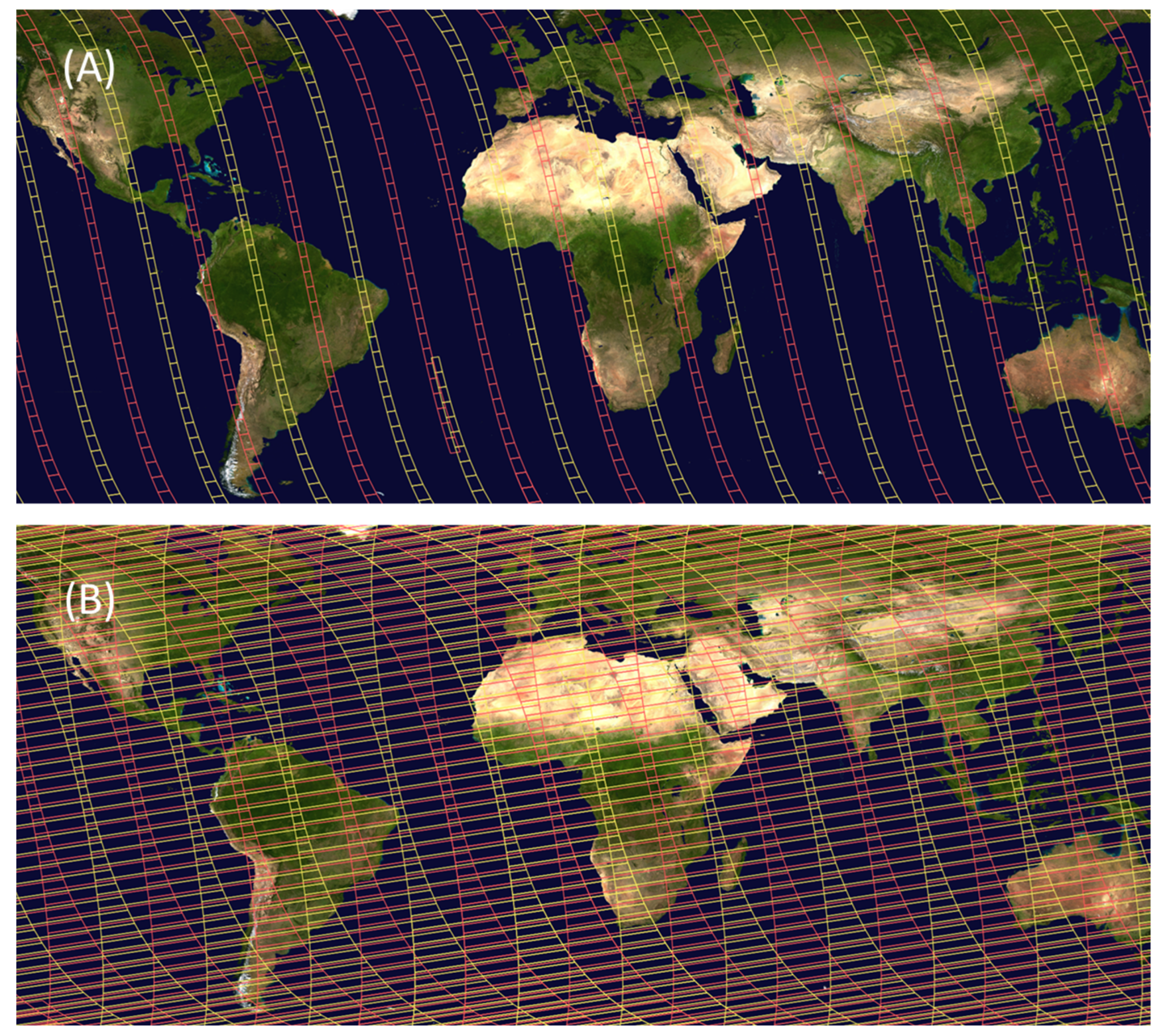
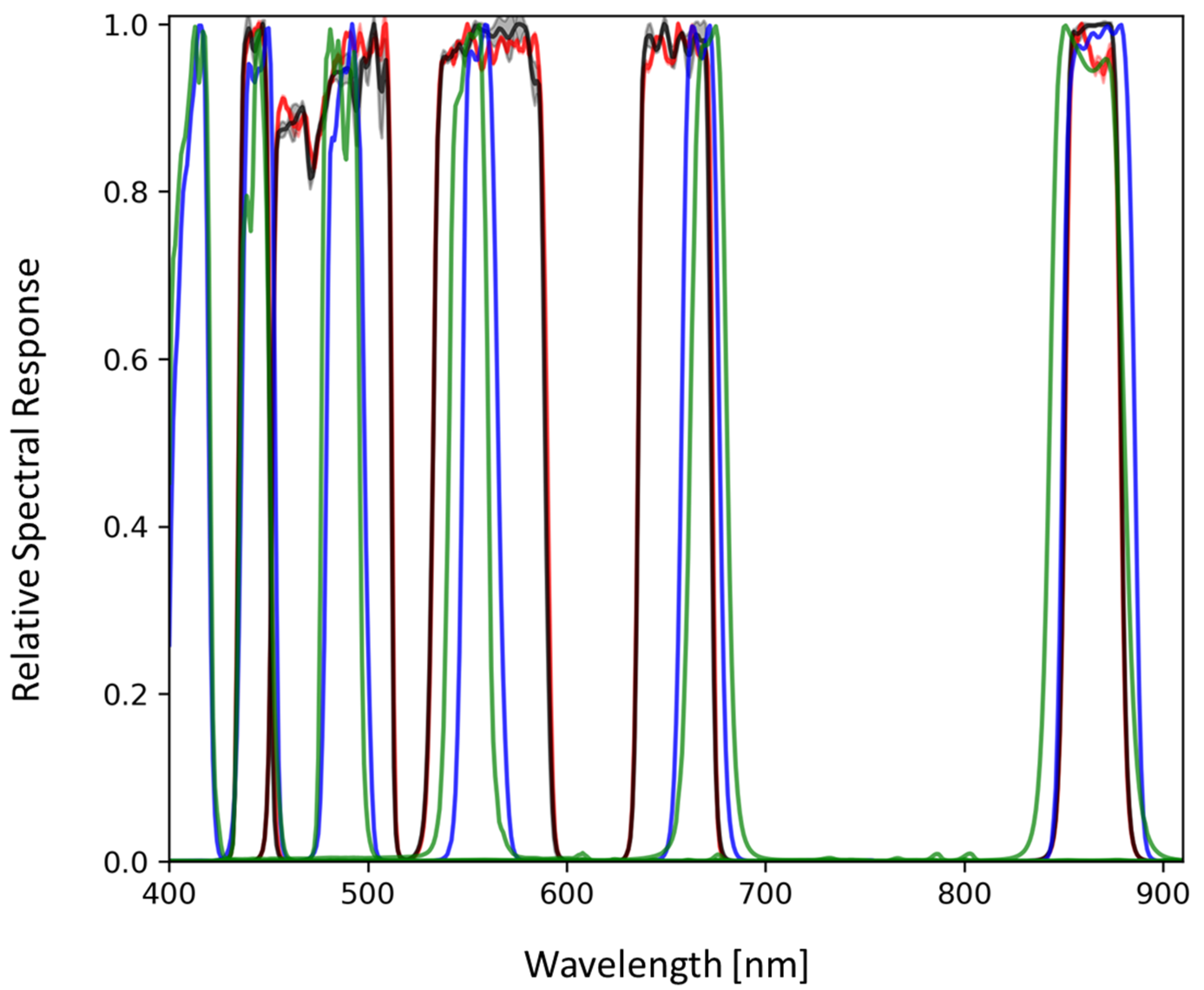
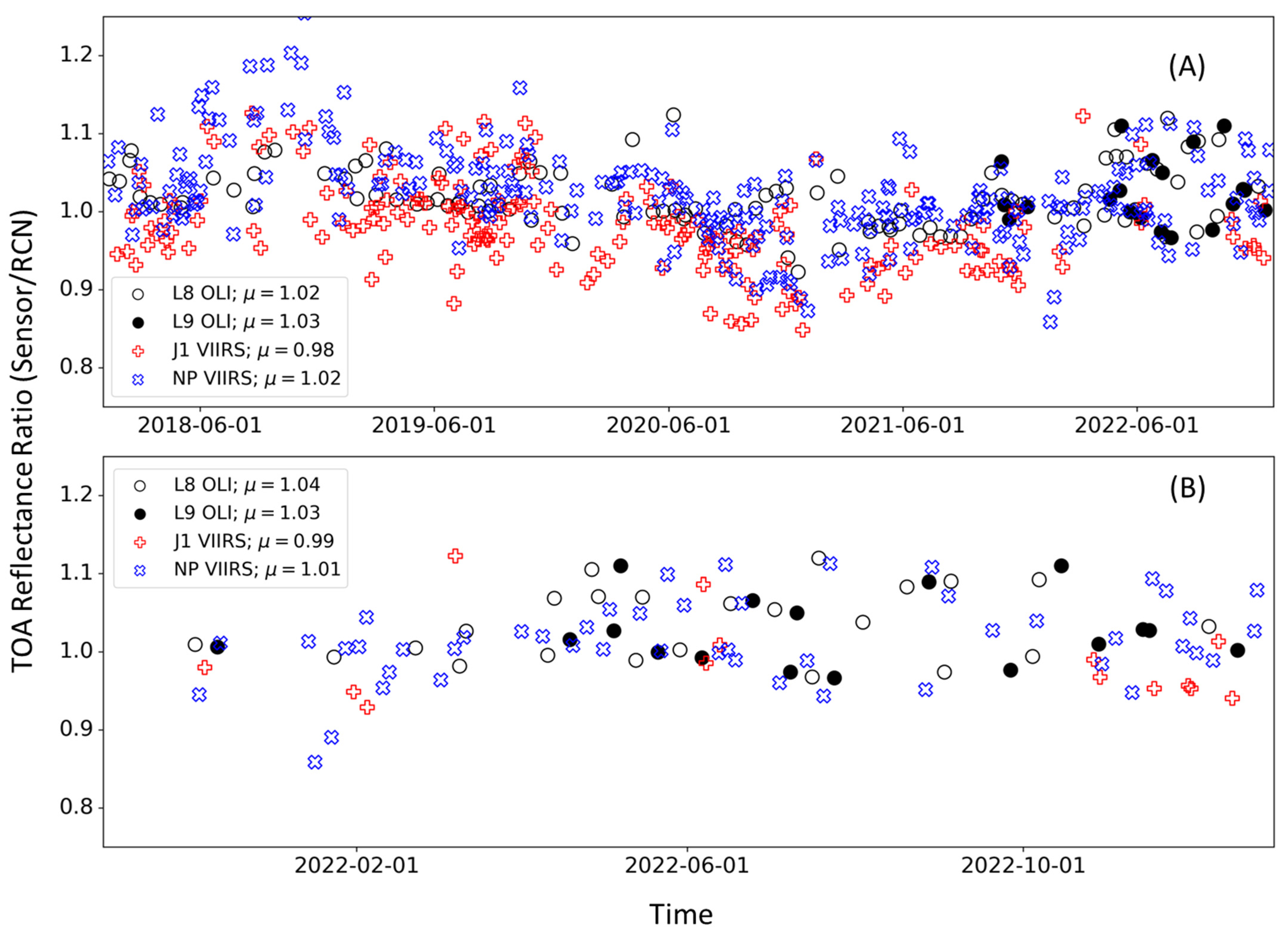
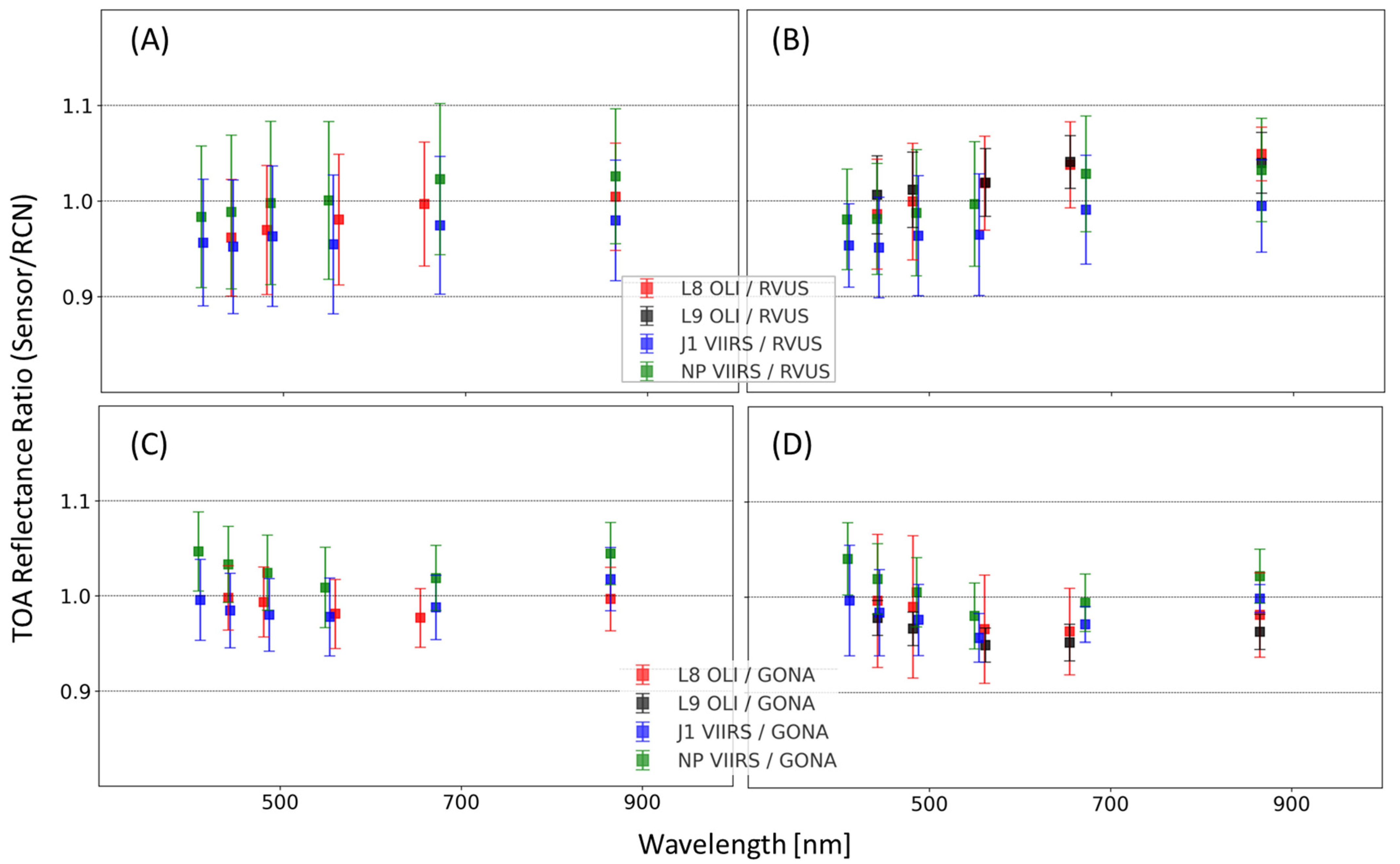
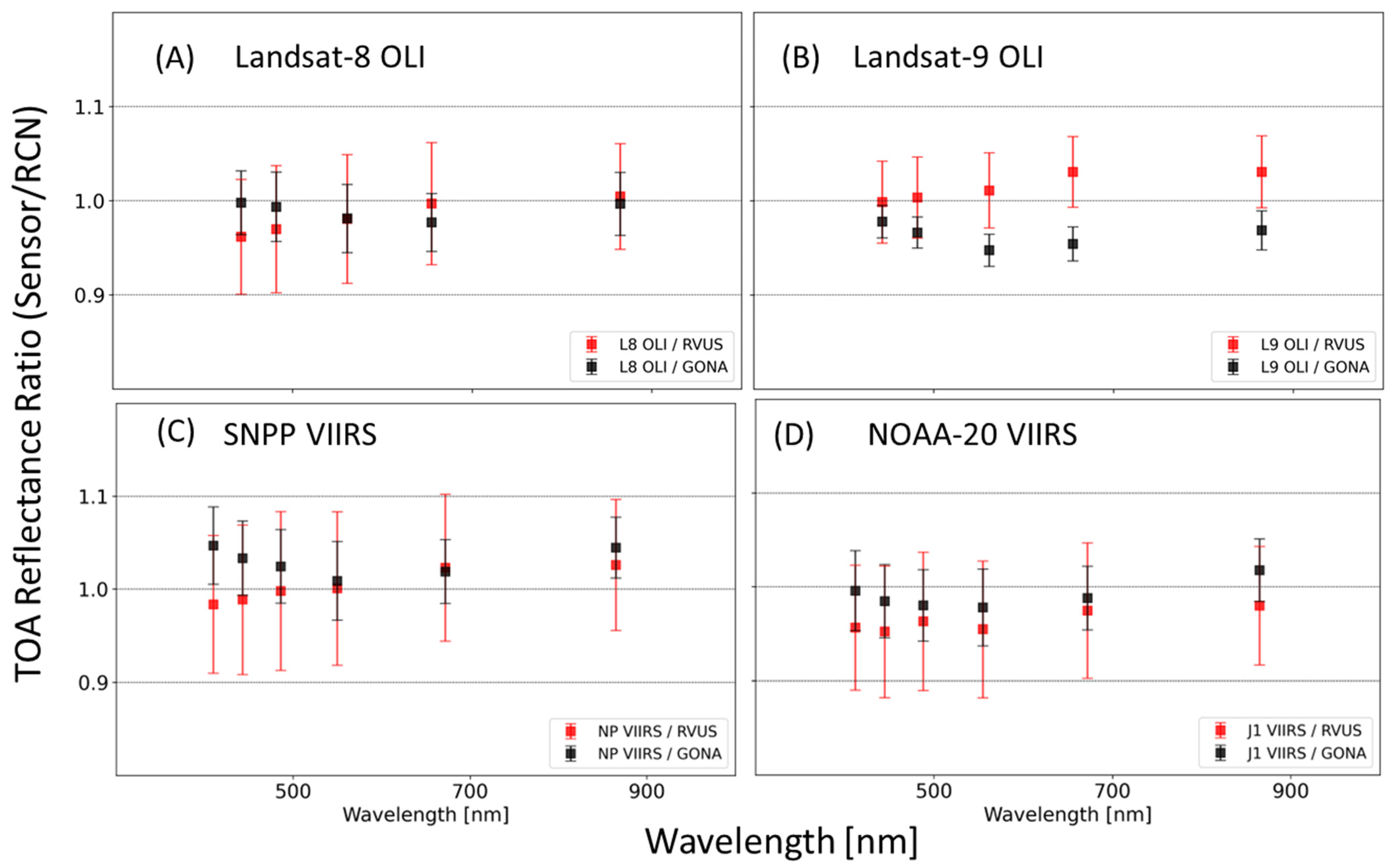
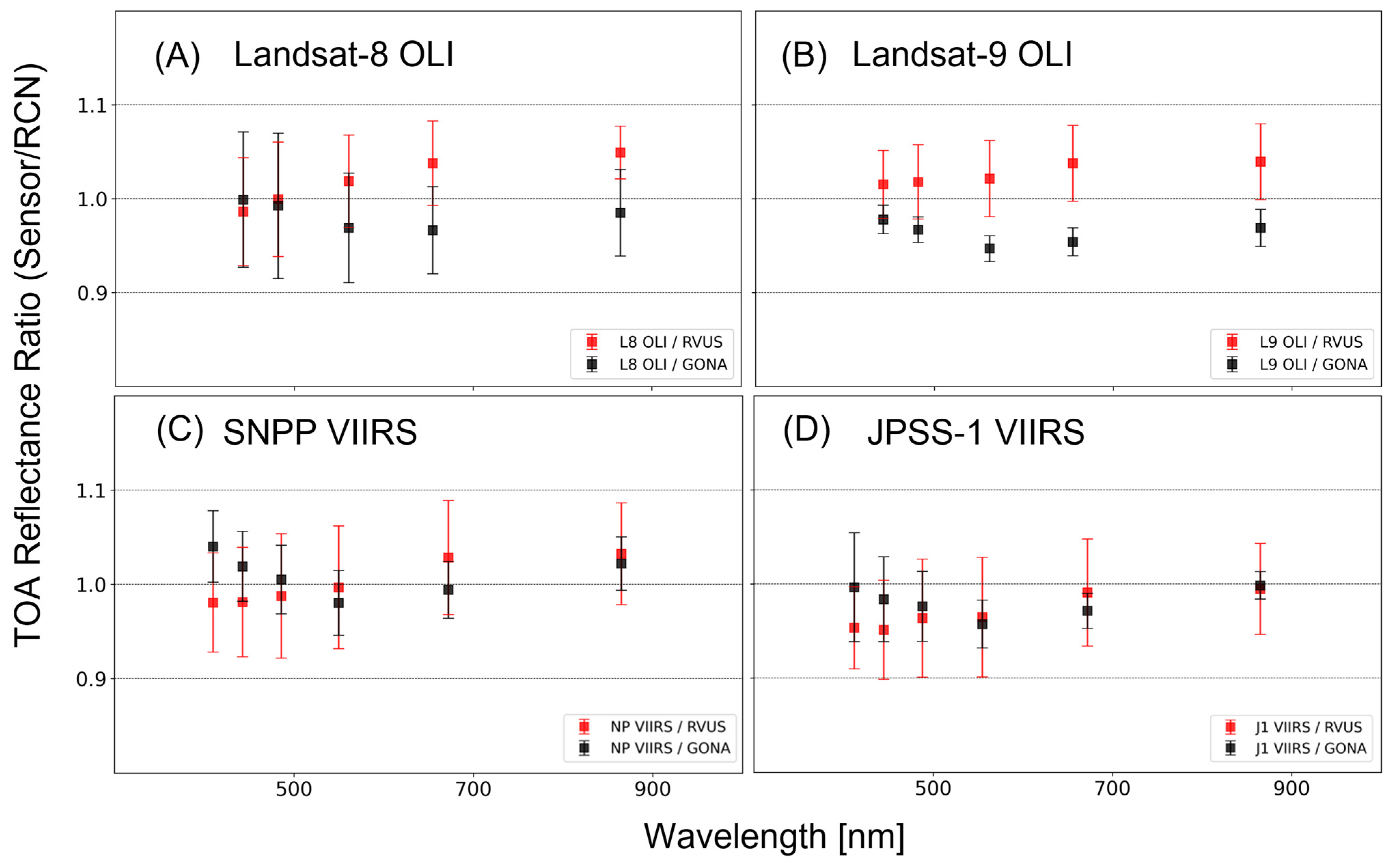
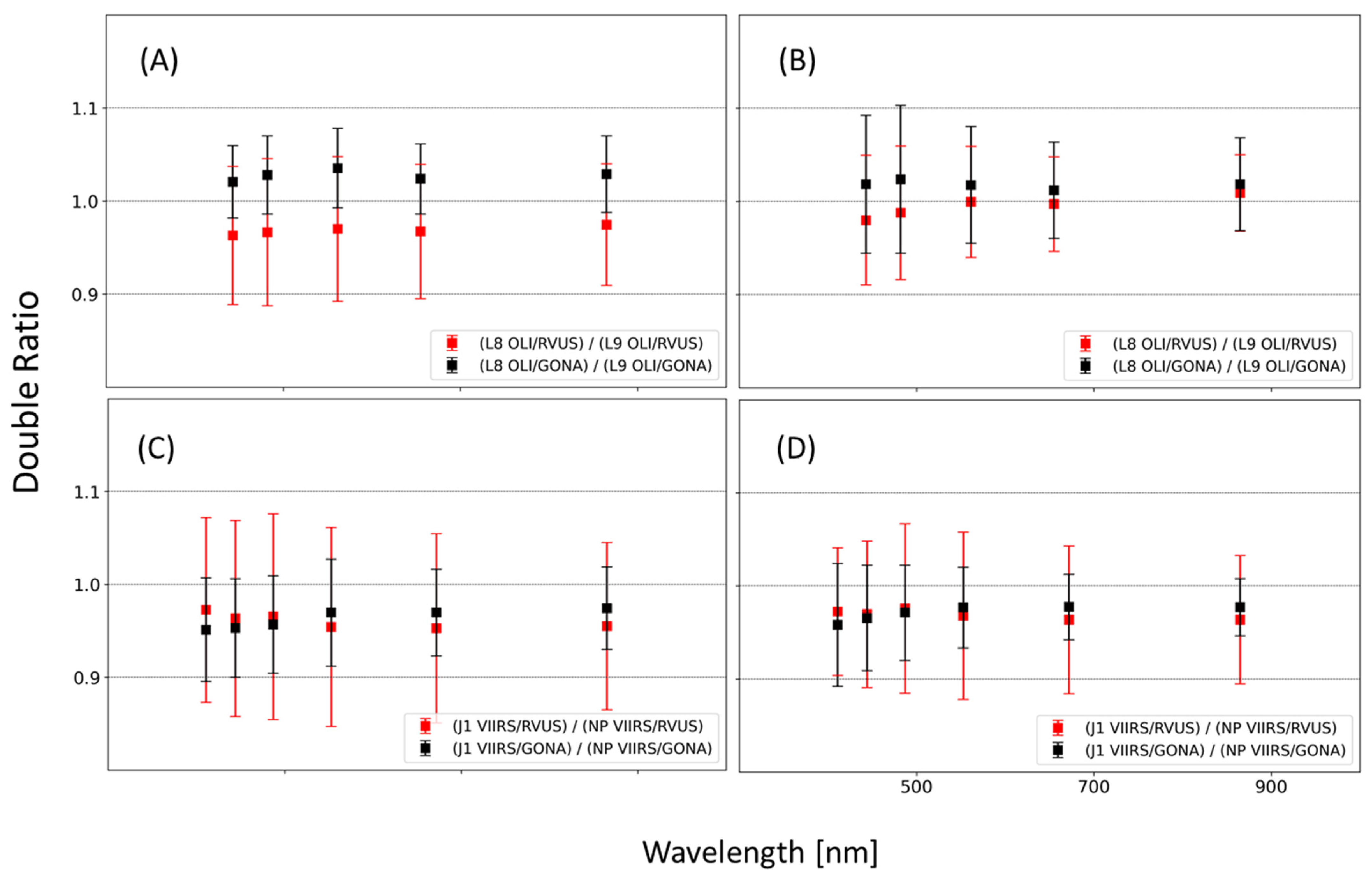
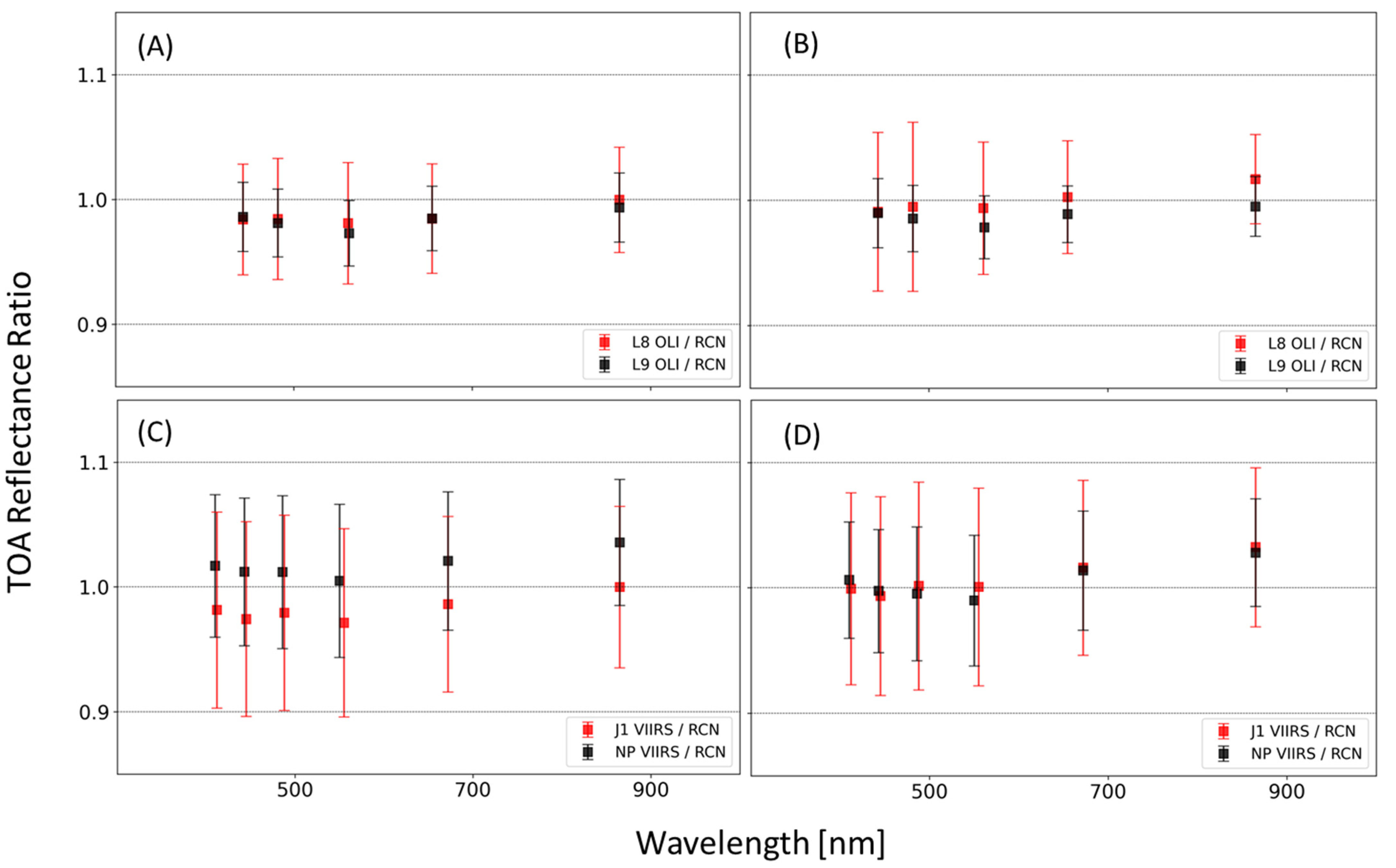
| Band Centers (nm) | |||||
|---|---|---|---|---|---|
| VIIRS Band Names | NOAA-20 VIIRS | SNPP VIIRS | Landsat-8 OLI | Landsat-9 OLI | OLI Band Names |
| M1 | 412 | 410 | - | - | - |
| M2 | 445 | 443 | 443 | 443 | B1 |
| M3 | 488 | 486 | 482 | 482 | B2 |
| M4 | 555 | 550 | 561 | 562 | B3 |
| M5 | 672 | 672 | 655 | 655 | B4 |
| M7 | 865 | 865 | 865 | 865 | B5 |
| Site | 4-Letter Name | Lat/Lon | Area [m2] |
|---|---|---|---|
| Railroad Valley | RVUS | (38.497, −115.690) | 1000 × 1000 |
| Gobabeb | GONA | (−23.600, 15.120) | π × 30 × 30 |
| La Crau | LCFR | (43.5589, 4.8642) | π × 30 × 30 |
| Baotou | BTCN | (40.8514, 109.6280) | 48 × 48 Gravels |
| Baotou Sand | BSCN | (40.8659, 109.6155) | 300 × 300 |
| Sensor | Launch | RVUS | GONA | ||
|---|---|---|---|---|---|
| Available | Good | Available | Good | ||
| Landsat-8 OLI | 2013 | 73 | 42 | 70 | 67 |
| Landsat-9 OLI | 2021 | 17 | 8 | 13 | 12 |
| SNPP VIIRS | 2011 | 349 | 114 | 411 | 127 |
| NOAA-20 VIIRS | 2017 | 339 | 98 | 327 | 93 |
| Sensor | Landsat-8 OLI | Landsat-9 OLI | SNPP VIIRS | NOAA-20 VIIRS |
|---|---|---|---|---|
| Time Difference | 20 (~30%) | 7 (47%) | 71 (~21%) | 73 (~23%) |
| View Geometry | 0 (0%) | 0 (0%) | 118 (~64%) | 188 (~41%) |
| Ground Variability | 8 (~12%) | 0 (~0%) | 15 (~4%) | 19 (~6%) |
| Location Ambiguity | 0 (~0%) | 0 (~0%) | 119 (~36%) | 98 (~31%) |
| Atmospheric Condition | 16 (~24%) | 8 (~53%) | 67 (~20%) | 68 (~21%) |
| Sensor | Landsat-8 OLI | Landsat-9 OLI | SNPP VIIRS | NOAA-20 VIIRS |
|---|---|---|---|---|
| Time Difference | 1 (~1%) | 0 (0%) | 1 (~0%) | 2 (~1%) |
| View Geometry | 0 (0%) | 0 (0%) | 227 (~57%) | 178 (~58%) |
| Ground Variability | 2 (~3%) | 1 (~7%) | 19 (~5%) | 13 (~4%) |
| Location Ambiguity | 0 (~0%) | 0 (~0%) | 133 (~34%) | 123 (~40%) |
| Atmospheric Condition | 1 (~1%) | 0 (~0%) | 2 (~1%) | 3 (~1%) |
Disclaimer/Publisher’s Note: The statements, opinions and data contained in all publications are solely those of the individual author(s) and contributor(s) and not of MDPI and/or the editor(s). MDPI and/or the editor(s) disclaim responsibility for any injury to people or property resulting from any ideas, methods, instructions or products referred to in the content. |
© 2023 by the authors. Licensee MDPI, Basel, Switzerland. This article is an open access article distributed under the terms and conditions of the Creative Commons Attribution (CC BY) license (https://creativecommons.org/licenses/by/4.0/).
Share and Cite
Tahersima, M.H.; Thome, K.; Wenny, B.N.; Voskanian, N.; Yarahmadi, M. Intercomparison of Landsat OLI and JPSS VIIRS Using a Combination of RadCalNet Sites as a Common Reference. Remote Sens. 2023, 15, 5562. https://doi.org/10.3390/rs15235562
Tahersima MH, Thome K, Wenny BN, Voskanian N, Yarahmadi M. Intercomparison of Landsat OLI and JPSS VIIRS Using a Combination of RadCalNet Sites as a Common Reference. Remote Sensing. 2023; 15(23):5562. https://doi.org/10.3390/rs15235562
Chicago/Turabian StyleTahersima, Mohammad H., Kurtis Thome, Brian N. Wenny, Norvik Voskanian, and Mehran Yarahmadi. 2023. "Intercomparison of Landsat OLI and JPSS VIIRS Using a Combination of RadCalNet Sites as a Common Reference" Remote Sensing 15, no. 23: 5562. https://doi.org/10.3390/rs15235562
APA StyleTahersima, M. H., Thome, K., Wenny, B. N., Voskanian, N., & Yarahmadi, M. (2023). Intercomparison of Landsat OLI and JPSS VIIRS Using a Combination of RadCalNet Sites as a Common Reference. Remote Sensing, 15(23), 5562. https://doi.org/10.3390/rs15235562










